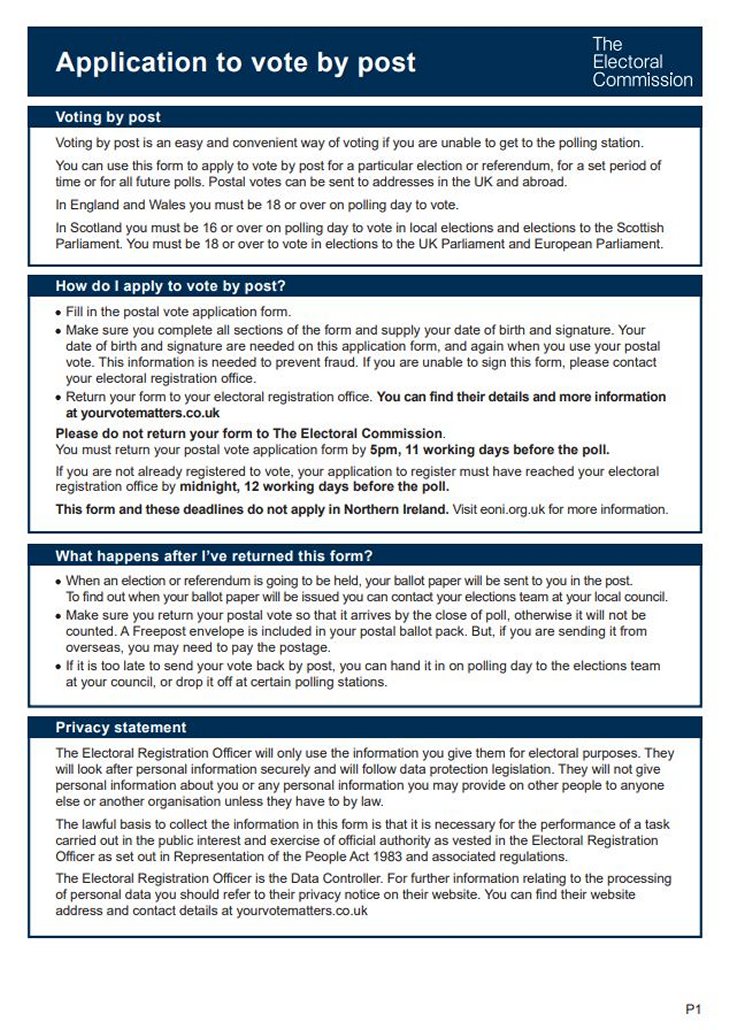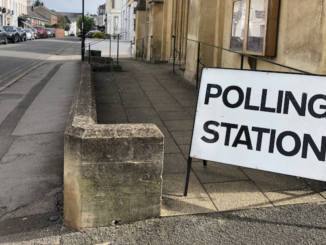
Open Government Licence v3.0
Apply-to-vote-by-post-England-Scotland-and-Wales.pdf
I have done one of these before but it never hurts to remind the Puffins what a travesty it all is.
There can be very few, if any, Puffins who are not aware of Postal Voting here in the UK. This will try to explain what goes on when you vote by post and the massive loopholes the system contains.
Firstly, if you decide to vote by post, or the Imam tells you to, you can download the application for a postal vote form that is freely available for download on the Electoral Commission website. You fill this in and return to to your local council electoral people. Technically you can request a postal vote by writing to the council but it is easier to use the form, it contains all the details you need to provide. You do not have to give a reason why you want to postal vote, it is your God given right to exercise should you wish.
The information on the form includes:
- Your name and address
- The address the form should be sent to if not your own and the reason (it needs to be compelling)
- When you want to have a postal vote
- Always
- On a specific date
- For a period
- Your date of birth
- Your signature
When the council receives the application, it is checked against the electoral roll and either approved or rejected. You then get a letter from them informing you of their decision. You can apply for a postal vote up to 11 working days before the poll.
You will then receive your postal vote pack either by post, or in my case the council seem to deliver it themselves. Your postal vote pack contains:
- Envelope A
- Envelope B
- Instructions
- The ballot paper
The ballot paper is exactly the same as the one you get at the polling station, you put an X next to your choice of candidate or spoil it by drawing rude pictures or writing obscene phrases upon it. The candidates and/or their agents will be shown all spoiled papers so your efforts will not be entirely wasted.
Envelope A has your details pre-printed on it. You need to fill in your date of birth and signature. These are checked against your original application which will have been scanned. Next you put your X on the ballot paper and place this inside envelope A which you then seal. Envelope A goes inside Envelope B which is just a Freepost addressed to the electoral officer. You then either post it or personally deliver it to the council offices. Depending on how many RoPers work for the Royal Mail in your area, you will know which course is best for you (they will be well aware of when their community’s postal votes are going in en masse).
It is also possible to return a postal vote to any polling station the constituency on polling day, anybody can return it, it doesn’t have to be the postal voter themselves. Hence the stories of the Peterborough and cars driving late to polling stations stuffed with postal votes. If that’s not suspicious I don’t know what is but apparently, it was “within the guidelines”. FFS.
When the electoral office receives your postal vote they should date and time stamp it and store it securely. The candidates and their agents are allowed to be present at any of the scheduled opening ceremonies, they have to be given 48 hours notice of such events.
At an opening ceremony, the guiding rule is that the ballot papers must be kept face down so nobody can see the details of how anyone voted. Of course, some will be seen but those present must pretend they haven’t seen them.
Firstly the B envelopes (those that enclose envelope A) are opened. This allows the staff to see the voter details while the date of birth and signature are checked against the application for a postal vote. At this point votes may be rejected for mismatches but those present can verify what is wrong. The observers are allowed to object to any rejection. It seems the electoral officer’s decision is final having listened to the objections. All the while counts of received and counted ballots are kept plus the postal voter is checked off on the list.
Having been checked off, envelope A is then opened and the ballot paper extracted. The ballot paper must be kept face down at all times. Check the number on the ballot paper matches the number on envelope A, if not it is rejected. The ballot paper is then placed in the postal ballot box. The ballot box is then sealed and the count of ballot papers is recorded.
Postal votes may be delivered to polling stations on election day. They will be collected periodically during the day because they still need to be processed at the council’s offices. With luck, by the end of the voting day at 10 pm, most will already have been processed leaving only a few stragglers yet to be checked.
This process takes us up to polling day and the count. when the sealed postal ballot boxes and their control paperwork must be sent to the count itself. During the count, the postal ballot boxes are unsealed and the number of ballot papers checked against the control paperwork. Finally they are mixed in with the ballot papers from the polling stations and this means although we will know how many postal votes were sent out, received back, accepted or rejected, we will never know how they voted or how many were spoiled. This seems quite deliberate though it could be justified if there was only one accepted postal ballot because that one person’s vote would not be secret. on the other hand, the wholesale rigging of postal votes by one particular community is very difficult to uncover.
You will notice the rules attempt to ensure only permissible people are allowed to postal vote and their vote remains secret. On the other hand because all the postal vote filling in takes place away from the eyes of officialdom it is wide open to abuse. The stories of mosque driven vote rigging are legion and although they need to be careful so they pass all the tests, there is no attempt to crack down on it. Any Labour MP whose majority is less than the number of postal votes must be suspect in my eyes.
The one really astounding thing to me is that the council is allowed to outsource the postal voting processes. I’m not sure I totally trust the council let alone any external company.
We can expect the postal vote fraud on December 12th 2019 will be off the scale. Labour are frit.
In a similar vein, it is possible there will be more Voter ID trials in certain areas though nothing has been notified yet so perhaps they are avoiding it. If there is, you can be certain it will not be in areas where it is really needed. In any case, the Voter ID will only be at polling stations, not for postal votes. Just for a laugh, these are the names of the organisations the Cabinet Office brought into the Voter ID discussions. I can see some justification for the RNIB and the Alzheimer’s people but the rest are just the standard list of Common Purpose stuffed lefties. I reckon they forgot to include the MCB (Muslim Council of Britain) accidentally on purpose.
- Stonewall
- LGBT Foundation
- Centrepoint
- Age UK
- Independent Age
- Alzheimer’s Society
- St Mungo’s
- Shelter
- Patchwork Foundation
- Operation Black Vote
- Race Equality Foundation
- National Union of Students (NUS)
- Equality and Human Rights Commission (EHRC)
- Mencap
- RNIB
To quote their report (the emphasis is mine)
The Minister for the Constitution proactively sought to engage these organisations, and personally met the majority of their representatives to discuss the pilots and listen to their suggestions and concerns. We are grateful for these groups’ time and their helpful contributions.
© well_chuffed 2019
The Goodnight Vienna Audio file
Audio Player



